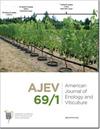A Novel Grape Downy Mildew Resistance Locus from Vitis rupestris
IF 1.8
3区 农林科学
Q3 BIOTECHNOLOGY & APPLIED MICROBIOLOGY
引用次数: 10
Abstract
The viticulture industry needs advanced grape cultivars with genes that enhance disease resistance and environmental stress tolerance to meet the challenges of a changing climate. To discover beneficial allelic variants of grape genes, we established an F1 mapping population from a cross between two North American grapevines, Vitis rupestris Scheele and Vitis riparia Michx. We generated genotyping-by-sequencing (GBS) markers and constructed parental linkage maps consisting of 1177 and 1115 GBS markers, respectively (LOD threshold ≥ 14), which were validated by mapping the sex-determining locus to chromosome 2. Taking advantage of loci heterozygous in both parents, we also constructed an integrated map containing 2583 markers. We mapped a major quantitative trait locus (QTL) for downy mildew (Plasmopara viticola) resistance to chromosome 10 of V. rupestris using both greenhouse- and in vitro-generated leaf resistance data. This QTL explains 66.5% of the phenotypic variance under greenhouse conditions, and its 2-LOD confidence interval corresponds to region 2,470,297 to 3,024,940 bp on chromosome 10 in the Vitis vinifera L. PN40024 reference genome sequence (assembly 12X.v2). We provide PN40024-projected positions of the GBS markers, which can be used as anchors to develop additional markers for the introgression of this V. rupestris haplotype into cultivated grape varieties.葡萄抗霜霉病新位点的研究
葡萄种植业需要先进的葡萄品种,这些品种具有增强抗病性和环境耐受性的基因,以应对气候变化的挑战。为了发现葡萄基因中有益的等位变异,我们从两种北美葡萄品种——葡萄(Vitis rupestris Scheele)和葡萄(Vitis riparia Michx)的杂交中建立了一个F1定位群体。我们生成了基因分型测序(GBS)标记,并构建了亲本连锁图谱,分别包含1177个和1115个GBS标记(LOD阈值≥14),通过将性别决定位点定位到2号染色体进行验证。利用双亲的位点杂合性,构建了包含2583个标记的综合图谱。利用温室和体外叶片抗霜霉病抗性数据,绘制了葡萄浆霉病对10号染色体抗性的主要数量性状位点(QTL)。该QTL解释了温室条件下66.5%的表型变异,其2-LOD置信区间对应于Vitis vinifera L. PN40024参考基因组序列(assembly 12X.v2) 10号染色体上2,470,297 ~ 3,024,940 bp区域。我们提供了GBS标记的pn40024投影位置,这些标记可以作为锚点,用于开发其他标记,以便将该葡萄葡萄单倍型导入栽培葡萄品种。
本文章由计算机程序翻译,如有差异,请以英文原文为准。
求助全文
约1分钟内获得全文
求助全文
来源期刊

American Journal of Enology and Viticulture
农林科学-生物工程与应用微生物
CiteScore
3.80
自引率
10.50%
发文量
27
审稿时长
12-24 weeks
期刊介绍:
The American Journal of Enology and Viticulture (AJEV), published quarterly, is an official journal of the American Society for Enology and Viticulture (ASEV) and is the premier journal in the English language dedicated to scientific research on winemaking and grapegrowing. AJEV publishes full-length research papers, literature reviews, research notes, and technical briefs on various aspects of enology and viticulture, including wine chemistry, sensory science, process engineering, wine quality assessments, microbiology, methods development, plant pathogenesis, diseases and pests of grape, rootstock and clonal evaluation, effect of field practices, and grape genetics and breeding. All papers are peer reviewed, and authorship of papers is not limited to members of ASEV. The science editor, along with the viticulture, enology, and associate editors, are drawn from academic and research institutions worldwide and guide the content of the Journal.
 求助内容:
求助内容: 应助结果提醒方式:
应助结果提醒方式:


